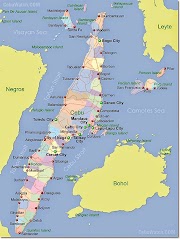1. Magellan's Wooden Cross
The Spanish expedition, headed by Ferdinand Magellan, first landed in Cebu in 1521. Magellan’s wooden cross still stands on Magallanes Street, Downtown, beside the Basilica Minore del Santo Niño. Ferdinand Magellan planted the cross to commemorate the baptism of local chief Rajah Humabon and his wife and their people on April 21, 1521. The original cross is safely contained inside the tindalo wood outer casing to protect it from people who chip away at it, believing it to be miraculous.
2. Basilica Minore del Santo Niño
The Basilica Minore del Santo Niño was built on the spot where a statue of the Child Jesus of Santo Niño – believed to have been brought by the Spaniards during the 1521 expedition – was found by the Spaniards when they returned to the island in 1565. The church, ran by the Augustinians, was first built out of wood and nipa in 1566 and later on constructed out of hard stone in 1735. The church museum traces the history of Christianity in Cebu.
3. Colon Street
Colon Street in Downtown, Cebu is the country’s oldest street. According to a SunStar Cebu article published in November 2007, the Women’s International League funded 25 Heritage sites on Colon to be marked for remembrance. These markers marked significant establishments of the early days and traditional homes alike.
4. Mactan Shrine
The Lapu-Lapu Marker and statue at the Mactan Shrine on Mactan Island commemorate the bravery of local chieftain Lapu-Lapu, who, on April 27, 1521, repulsed the Spanish invaders, killing their leader, Ferdinand Magellan, thus becoming the first Filipino to repulse European invaders. He is the city’s well-loved hero.
5. Fort San Pedro
Fort San Pedro built by Miguel Lopez de Legaspi in 1565 and finished around 200 years later in 1738, is the smallest and oldest fort in the country. With walls 20-feet high and 8-feet thick, the Spaniards used it to repel natives and Muslims; the Japanese, during World War II, used it as a hospital; it was an army camp during the years of liberation; and, in more recent years, a garden club experiment (1950) and a zoo (1957), before it evolved to what it is now, a tourist attraction. All cab drivers know where Fort San Pedro is (Barangay San Roque, Cebu) though it’s best to come right after your visit to Taboan Dried Fish Market (Carbon, Cebu) for danggit or dried fish (P300/kilo) when it’s still not too hot to explore.
6. Fuente Osmeña, Cebu
Driving around the city, there is no escaping the rotunda that is Fuente Osmeña circle, a small park marked by its famous fountain built to commemorate the city’s first waterwork construction (it’s the fountain on the right side of the fifty-peso bill), named to honor the fourth Philippine President Osmeña. When you see it, you know you’re in Uptown Cebu where many hotels, shops and restaurants are located. One of the four streets Fuente Osmeña opens to is Osmeña Avenue, where the former President Osmeña’s house still stands. The street ends right smack in front of the Provincial Capital Building, a massive colonial-style structure that is the city’s seat of government.
source:yahoo









1 Comments
I pay a visit everyday a few blogs and information
ReplyDeletesites to read posts, except this website offers quality based content.
My website: Cheap Flights From Vancouver To Bali Indonesia